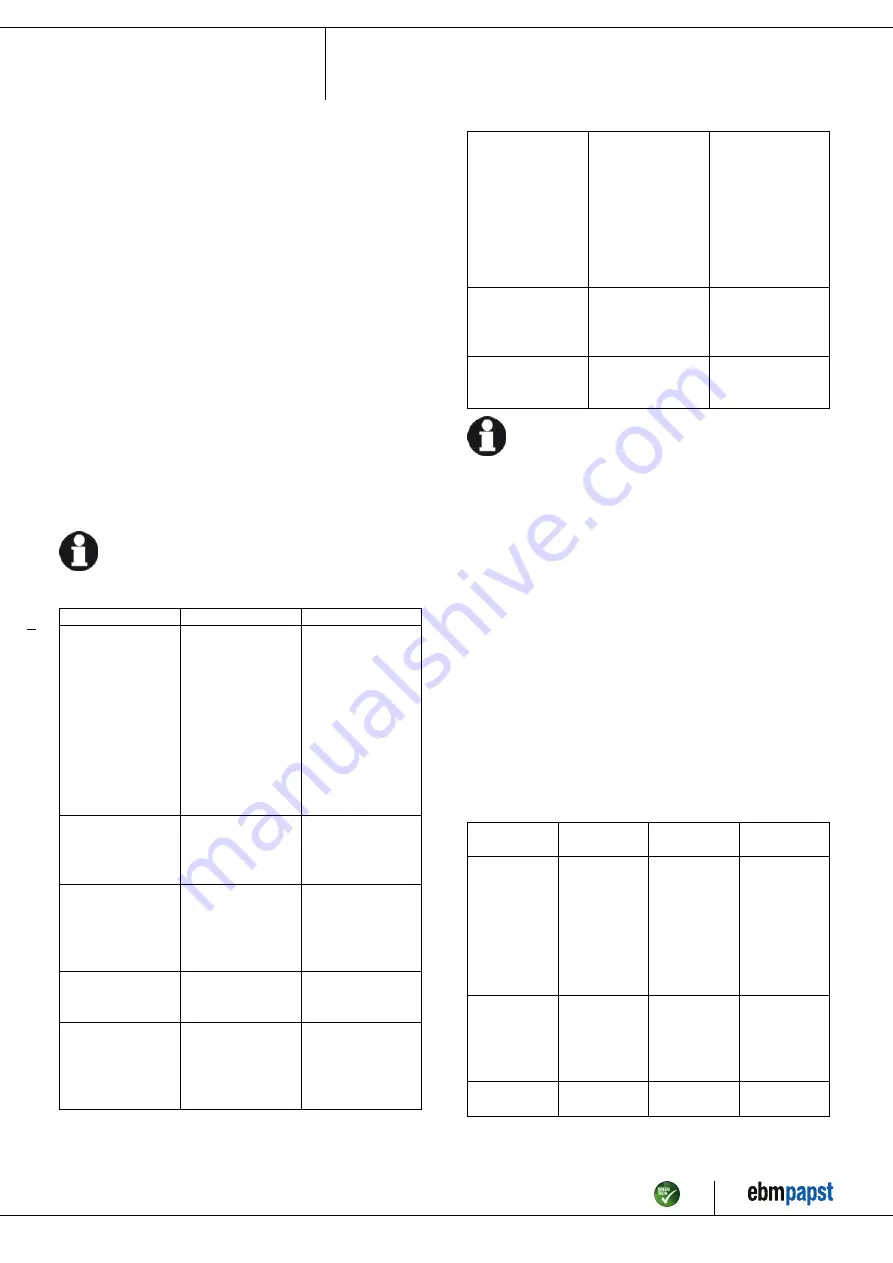
Operating instructions
S3G250-BC54-01
Translation of the original operating instructions
6. MAINTENANCE, MALFUNCTIONS, POSSIBLE
CAUSES AND REMEDIES
Do not perform any repairs on your device. Return the device to ebm-
papst for repair or replacement.
WARNING
Terminals and connections have voltage even with a
unit that is shut off
Electric shock
→ Wait five minutes after disconnecting the voltage at all poles
before opening the device.
CAUTION
If control voltage is applied or a speed setpoint is stored,
the motor automatically restarts, e.g. after a power failure.
Danger of injury
→ Keep out of the danger zone of the device.
→ When working on the device, switch off the mains
supply voltage and secure the latter from being switched on
again.
→ Wait until the device stops.
→ After working on the device, remove any used tools or
other objects from the device.
If the device remains out of use for some time, e.g. when in
storage, we recommend switching the device on for at least
two hours to allow any condensate to evaporate and to move
the bearings.
Malfunction/error
Possible cause
Possible remedy
Impeller running
roughly
Imbalance in rotating
parts
Clean the device; if
imbalance is still
evident after
cleaning, replace the
device.
If you have
attached any weight
clips during cleaning,
make sure to
remove them
afterwards.
Motor does not turn
Mechanical blockage
Switch off, de-
energise, and
remove mechanical
blockage.
Mains supply
voltage faulty
Check mains supply
voltage,
restore power
supply,
apply control signal.
Faulty connection
De-energise, correct
connection, see
connection diagram.
Thermal overload
protector responded
Allow motor to cool
off, locate and rectify
cause of error, if
necessary cancel
restart lock-out
Overtemperature of
electronics/motor
Insufficient cooling
Improve cooling. Let
the device cool
down.
To reset the error
message, switch off
the mains supply
voltage for a min. of
25 s and switch it on
again.
Ambient temperature
too high
Reduce the ambient
temperature.
Reset by reducing
control input to 0.
Unacceptable
operating point
Correct the operating
point. Let the device
cool down.
If you have any other problems, contact ebm-papst.
6.1 Cleaning
NOTE
Damage to the device during cleaning.
Malfunction possible
→ Do not clean the device using a water jet or high-pressure
washer.
→ Do not use any cleaners containing acids,
bases or solvents.
→ Do not use any pointed or sharp-edged objects to clean.
6.2 Safety test
NOTE
High-voltage test
The integrated EMC filter contains Y capacitors. Therefore, the
trigger current is exceeded when AC testing voltage is applied.
→ Test the device with DC voltage when you carry out the
high-voltage test required by law. The voltage to be used
corresponds to the peak value of the AC voltage required by
the standard.
What has to
be tested?
How to test?
Frequency
Which
measure?
Check the
protective
casing against
accidental
contact for
damage and to
ensure that it is
intact
Visual inspection At least every
6 months
Repair or
replacement of
the device
Check the
device for
damage to
blades and
housing
Visual inspection At least every
6 months
Replacement
of the device
Mounting the
connection lines
Visual inspection At least every
6 months
Fasten
Item no. 50334-5-9970 · Revision 82795 · Release 2014-05-08 · Page 9 / 10
ebm-papst Mulfingen GmbH & Co. KG · Bachmühle 2 · D-74673 Mulfingen · Phone +49 (0) 7938 81-0 · Fax +49 (0) 7938 81-110 · [email protected] · www.ebmpapst.com




























